Monitoring and Evaluation
Most M&E challenges, such as a lack of sufficient investment and capacities, are not specific to CVA. But those that are relate primarily to monitoring outcomes for unrestricted transfers. The flexibility of cash transfers can make it difficult to determine appropriate outcome indicators, as they may involve a combination of sector-specific and cross-cutting indicators. At the same time, there are limitations on gathering accurate data on how cash transfers are spent.
Grand Bargain signatories have committed to ensuring relevant M&E mechanisms are in place for cash, and increasing understanding of the costs, benefits, impacts and risks of cash relative to other modalities. Building on this, the GB cash workstream has action points including the development of common outcome indicators for multipurpose cash, and metrics for analysing value for money. Systematic value for money analysis has been limited by factors including a lack of agreed upon approaches, the need for quality outcome data, and the intensive nature of the analysis.
Current priorities
As part of the Grand Bargain cash commitments, the CALP Network has co-led (with USAID and CRS) the development of Multipurpose Cash Outcome Indicators. The draft for testing is currently available in English, French and Spanish via the library.
Related initiatives
Featured content

Multipurpose Cash Outcome Indicators – Final Draft for Testing
Guidelines and Tools
Note that the MPC indicators have now been revised. Please click here to access the updated Multipurpose Outcome Indicators and Guidance, which is available in Arabic, English, French and Spanish. Multipurpose Cash Outcome Indicators – Final Draft for Testing Multipurpose cash (MPC) is a type of assistance intended to enable people to meet their basic needs through local...

Monitoring 4 CTP: Monitoring Guidance for CTP in Emergencies
Guidelines and Tools
This guidance provides a central resource to promote a common understanding of the most important monitoring considerations for humanitarian projects using cash transfer programming (CTP). The primary audience for this guidance is field-level practitioners, from organisations directly involved in the design, implementation, monitoring, and accountability of projects using cash and vouchers...

Cost-Efficiency Analysis of Basic Needs Programs: Best Practice Guidance for Humanitarian Agencies
Guidelines and Tools
The Efficiency, Effectiveness and Value for Money Sub-Workstream is pleased to share the final output on Cost-Efficiency Analysis of Basic Needs Programs: Best Practice Guidance for Humanitarian Agencies (attached).
Cost-efficiency analysis estimates the ratio of program costs to outputs created, allowing you to compare cost-per-output for programs which all produced the same output. Such...
Thematic lead
Latest
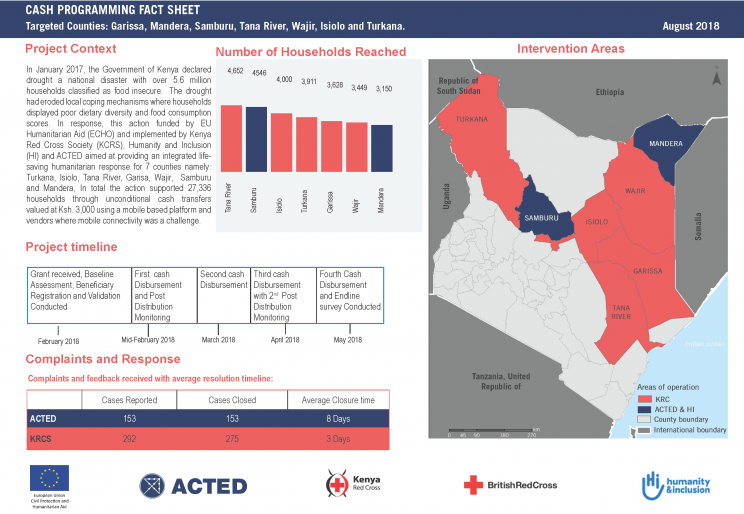
Cash Programming Fact Sheet
Report
A cash programming fact sheet demonstrating cash intervention in Kenya funded by EU Humanitarian Aid (ECHO). The program objective was to increase access to humanitarian assistance for vulnerable and drought-affected populations in the ASAL counties of Kenya.
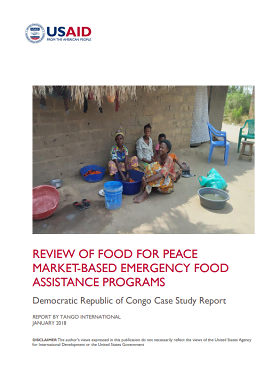
Review of Food for Peace Market-Based Emergency Food Assistance Programs: Democratic Republic of Congo Case Study Report
Report
The Democratic Republic of Congo (DRC) case illustrates the complexity and diversity of contexts within which program design and implementation occurs. It highlights the need for provincial-scale assessments, local market monitoring, and flexibility to pivot to different modalities depending on changing...

Reflecting on the 2017 Drought Response and Cash Coordination in Kenya
Report
This report brings together thoughts and reflections on the use of cash in the drought response in Kenya in 2017/18 and consider how cash coordination might be strengthened in future. These are from a half day learning event organised by the CALP Network in liaison with the Chair and Co-Chair of the Kenya...
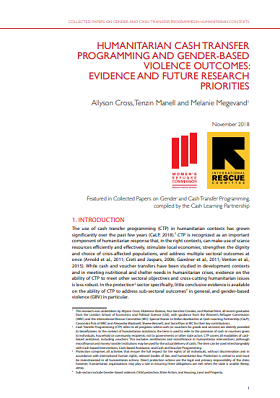
Humanitarian Cash Transfer Programming and Gender-based Violence Outcomes: Evidence and Future Research Priorities
Report
From ‘Collected Papers on Gender and Cash Transfer Programmes in Humanitarian Contexts’. Existing gender inequalities mean that disasters and conflicts impact women, men, girls and boys differently. Cash based assistance is one of the most significant developments in humanitarian assistance in recent...
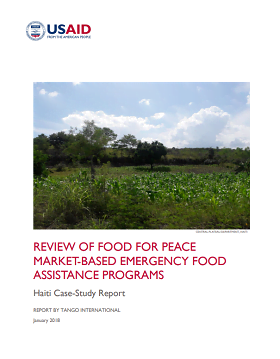
Review of Food for Peace Market-Based Emergency Food Assistance Programs: Haiti Case-Study Report
Report
Haiti is a very low-income country with a degraded ecological setting that faces repeated threats from multiple hazards. It is an excellent example of Food for Peace (FFP) linking emergency and development funding through the Kore Lavi Title II program that serves as a model for the national social...

“Breaking Barriers to Girls’ Education by Breaking Cycles of Poverty” Cash Transfers in South Sudan: A Case Study
Case Study
From ‘Collected Papers on Gender and Cash Transfer Programmes in Humanitarian Contexts’. Existing gender inequalities mean that disasters and conflicts impact women, men, girls and boys differently. Cash based assistance is one of the most significant developments in humanitarian assistance in recent...

Review of Food for Peace Market-Based Emergency Food Assistance Programs: Jordan/Turkey Case Study Report
Report
Syria regional crisis: The response to the Syria regional crisis exemplifies the challenges and opportunities involved with delivering food assistance in a widespread, largely urban refugee and internally displaced persons (IDP) crisis affecting middle-income countries. This case study focuses on...

Basic Needs Assessment Report BNA Pilot in Fafan zone, Ethiopia
Report
The BNA in Ethiopia identified Tuliguled as the woreda where deprivation across all basic needs has the most severe humanitarian consequences for the population in the assessed sites . Babile and Kebribeyah were the next most affected. This situation was due mostly to insufficient purchasing power and...

Inter-Agency Joint Cash Study: Market Functionality and Community Perception of Cash Based Assistance – Yemen
Report
Since 2015, conflict in Yemen has left 3 million people displaced and over half of the population food insecure, and has destroyed much of the country’s infrastructure. As of July 2017, much of the population had lost their primary source of income, 46% lacked access to a free improved water source and...
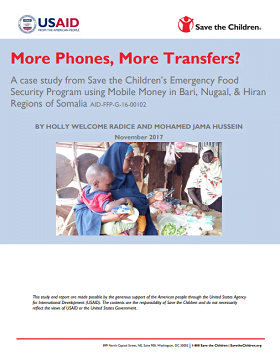
More Phones, More Transfers? A case study from Save the Children’s Emergency Food Security Program using Mobile Money in Bari, Nugaal, & Hiran Regions of Somalia
Report
In 2016-2017, with funding from USAID/FFP, Save the Children implemented a project targeting over 10,000HH the Bari, Nugaal, and Hiran regions of Somalia with monthly cash transfers using Mobile Money a partnership with Golis and Hormuud. The project sought to improve the food security situation in the...

Global Framework for Action
Guidelines and Tools
This framework provides a consolidated summary of the major commitments and recommendations made to improve cash transfer programming in humanitarian response during 2015 and 2016. It aggregates the core content of: the Grand Bargain, ECHO’s 10 Principles, the High Level Panel report, the Strategic Note...

Harnessing Digital Technology for Cash Transfer Programming in the Ebola Response. Lessons Learned from USAID/Office of Food for Peace Partners’ West Africa Ebola Responses (2015–2016)
Report
Globally, the adoption of digital technology has grown alongside the increase in cash transfer programming (CTP), often through the use of e-transfers, in part because of the potential gains in accountability, efficiency (cost and time) and effectiveness. The 2015 High Level Panel on Cash Transfers...

Final Evaluation of the DiRECT Response Emergency Cash Transfer Programme in Zambia
Report
In the past two years (2015 and 2016), Zambia experienced relatively harsh climatic conditions characterised by disruptive rains and the negative impact of El Nino weather patterns. Districts in the southern and western regions of the country were most affected. Many farmers in the affected regions were...
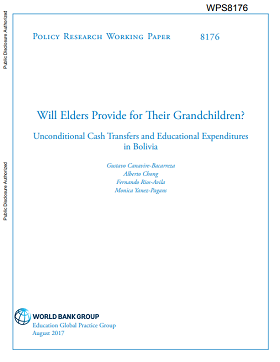
Will Elders Provide for Their Grandchildren? Unconditional Cash Transfers and Educational Expenditures in Bolivia
Report
This paper takes advantage of repeated cross-section household surveys and a sharp discontinuity created by the introduction of an unconditional cash transfers to elders.The paper evaluates the impact of these cash transfers on the educational expenditures for children within a household. The analysis...
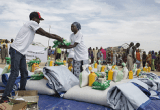
Emergency Response Programming – New Market-Analysis Skills Training Available [Eng/Fr/Arabic]
Blog Post
Market analysis is a core part of the suite of assessments that should help to inform all emergency response programming – these new courses will ensure you’re fully equipped with the knowledge you need to consider and work through local markets whenever possible.

Walking the talk: The Grand Bargain & Cash Transfer Programming
Blog Post
Cash Transfer Programming (CTP) is here to stay. The political battle has been won – cash is now accepted as part of the humanitarian response toolkit, and the will to increase its use is there. Now we need to bring this will to life, and turn our commitments into action.
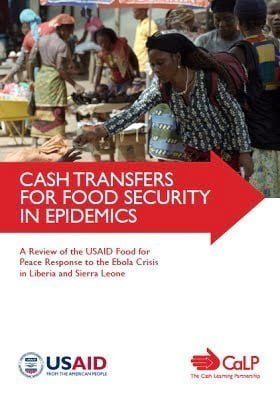
Cash Transfers for Food Security in Epidemics
Report
The report is divided into five chapters. The introduction provides a brief overview of the study’s objectives, data collection methods and a snapshot of the context in Liberia and Sierra Leone. The second chapter describes USAID/FFP’s response to the Ebola crisis with a particular focus on CTP....

Early Lessons Learnt from Cash Transfer Interventions in Post Matthew Haiti
Report
This technical report has twofold purposes, firstly to describe the main international evidence on cash transfer programing pertinent for the Haitian post Matthew emergency context; and secondly, to document the main lessons that can be learnt from the UNDP post Matthew cash transfer intervention. The...
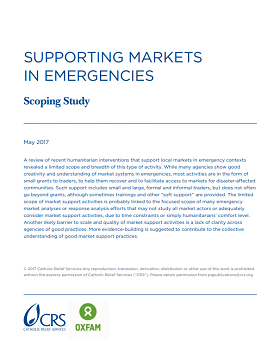
Supporting markets in emergencies. Scoping study
Report
A review of recent humanitarian interventions that support local markets in emergency contexts revealed a limited scope and breadth of this type of activity. While many agencies show good creativity and understanding of market systems in emergencies, most activities are in the form of small grants to...
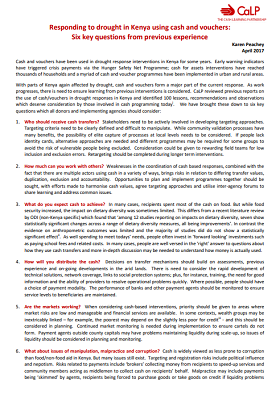
Responding to Drought in Kenya Using Cash and Vouchers: Six Key Questions from Previous Experience
Guidelines and Tools
the CALP Network reviewed previous reports on the use of cash/vouchers in drought responses in Kenya and identified 100 lessons, recommendations and observations which deserve consideration by those involved in cash programming today. We have brought these down to six key questions which all donors and...



